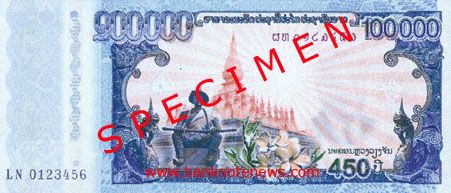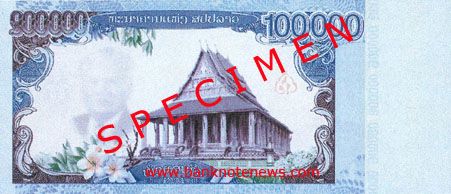On the occasion of the 450th anniversary of Vientiane becoming the “capital of Laos” – to be marked with a state spectacular at the National Stadium tonight – the central bank has issued a commemorative banknote with the denomination of 100,000 Kip (images here, other Lao banknotes here).
The Vientiane Times has reported concerns that high denomination banknotes might put pressure on inflation. According to a spokesman for the Lao National Economic Research Institute, a shortage of low denomination banknotes in circulation forces traders to sell goods and services at higher prices, not least to avoid providing small change. Bank officials reject these concerns and stress that the total amount of money in circulation will remain unchanged. Yet, there are indeed sometimes problems getting change, e.g. for the 50,000 Kip note, especially in the countryside.
Since the economic reforms of 1986, inflation has entailed the need for banknotes with higher denominations every couple of years. The first series of the “New Kip” (1-100 Kip, 1979) was in 1988 supplemented with a 500 Kip note which was still characterized by socialist iconography with images of agricultural and technological development.
The collapse of the Soviet Union and the redrafting of the constitution in 1991 marked a break in Lao state symbolism. The “Great Stupa” That Luang replaced star, hammer and sickle in the national coat-of-arms and took a prominent position on the front of the 1,000 Kip note issued in 1992. The well-known icon of the three women dressed in ethnic clothes – representing the “Lao multi-ethnic people” (pasason lao banda phao) – also found its way onto Lao money.
References to ethnic diversity disappeared on banknotes issued in 1997 (2,000 and 5,000 Kip) and 2002 (10,000 and 20,000 Kip). Kaysone Phomvihane, strongman of the Lao People’s Revolutionary Party and its secretary-general from 1955 to his death in 1992, became the dominant icon. Next to him Buddhist icons such as That Luang and the famous temple Vat Xieng Thong (Luang Prabang) were displayed. The Kip visualized the official ideology of post-reform Laos: the need of a strong revolutionary party with a commitment to cultural heritage protection and development (the latter illustrated with a Mekong bridge on the back of the 10,000 Kip note, for instance).
The 50,000 Kip note issued in 2006 was a more pronounced statement of national sovereignty, with Kaysone and That Luang on the front and the Presidential Palace on the back instead of icons of development. The focus on Vientiane as political and cultural centre of the Lao nation is already remarkable here.
The new 100,000 Kip note illustrates recent tendencies in Lao politics of national identity: A search for national “ancestors” (banphabulut) in the historical Lan Sang kingdom and increasing iconographical exploitation of Buddhist royalty, as manifest in the statues of Fa Ngum and Anouvong. A particularly illuminating example was the enactment of Fa Ngum’s speech after his capture of Vientiane in 1357 at the opening ceremony of the SEA Games in 2009.
The 100,000 Kip note shows the statue of King Setthathilat in front of the That Luang. Setthathilat moved his capital from Luang Prabang to Vientiane 450 years ago and built this famous stupa. An oil painting in the Army History Museum shows Setthathilat observing the construction of the That Luang – the birth of Vientiane as the capital of Laos according to the official historiography. Moreover, Setthathilat brought the Emerald Buddha (Pha Kaeo) to Vientiane and erected the Ho Pha Kaeo to house the precious statue. The Ho Pha Kaeo, destroyed by the Siamese and rebuilt under the French colonial administration, can be seen on the reverse side of the banknote. This icon is ambivalent, though, since it represents both Lao cultural heritage and the loss of the Pha Kaeo to Bangkok. Here is a connection to the recent erection of the statue for Chao Anouvong. Lao history books suggest that one of the aims of his fateful military campaign against Bangkok had been to retrieve the Pha Kaeo to bolster his desired sovereignty.
Interestingly, Kaysone appears on the new banknote only as watermark – a faded, lingering presence like a kind of ancestor ghost. Except for his appearance as the “face” of the LPRP, there is no reference to the revolutionary struggle or to the regime’s focus on socio-economic development. Further icons are dok champa, the “national flower” of Laos, and the naga, protective deities in Lao Buddhist tradition.
All in all, the note presents an allegoric image of the Lao nation as based on the cultural and political heritage of ethnic Lao Buddhist civilization. The idea of the “multi-ethnic people” is completely lacking here. I expect that future banknotes in Laos will rather show the statues of Fa Ngum and Anouvong than icons of ethnic diversity. It remains to be seen if revolutionary iconography will have a comeback or if the legacy of Lan Sang will gain prominence. The official celebration of the 450th anniversary of the capital in the National Stadium might give some hints to the future of Lao nation-building.
Oliver Tappe is research fellow at the Max Planck Institute for Social Anthropology in Halle/Germany and did his PhD-thesis on Lao historiography and nation-building politics. A chapter dedicated to the iconography of the Lao Kip has been published as a journal article (“A New Banknote in the People’s Republic – The Iconography of the Kip and Ideological Transformations in Laos, 1957-2006.” Internationales Asienforum 38/1-2: 87-108).
 Facebook
Facebook  Twitter
Twitter  Soundcloud
Soundcloud  Youtube
Youtube  Rss
Rss 
